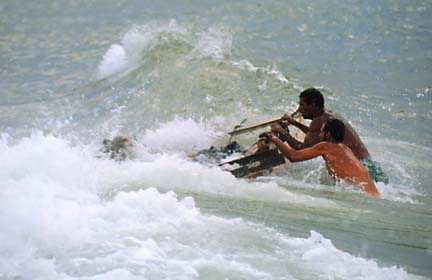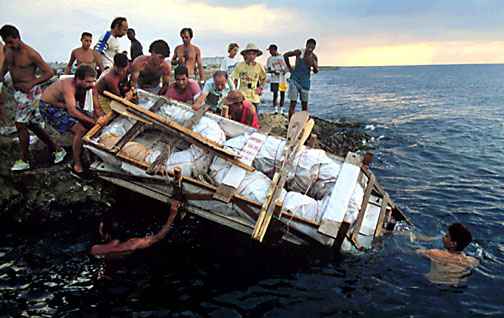August 2, 2004
Cuban Rafter Multimedia Archive

Between 1959 and 1994, in defiance of Cuban law, more than 63,000 citizens left Cuba by sea in small groups and reached the United States alive. Thousands more washed up in the Bahamas, the Cayman Islands and other Caribbean shores. Over the years, they have been collectively known as balseros (rafters) and their precarious vessels as balsas (rafts). At least 16,000 additional rafters did not survive the crossing.
Over the summer of 2004, I had the opportunity to develop a multimedia archive on this topic working with Dr. Holly Ackerman, one of the world's experts on this rafter phenomenon. The result was The Cuban Rafter Phenomenon: A Unique Sea Exodus.

Project Challenge
This challenge for this interactive multimedia website was to create a digital environment to explore the experience of the thousands of citizens who left Cuba in small boats, homemade rafts and other unusual craft. The site would focus on those who precipitated and participated in one specific sea exodus � the raft crisis of 1994. Through photos, videos, bibliography, primary documents and narratives the site would examine the 1994 crisis and, by extension, begin to investigate the nature of the larger theme of post-1980 Cuban migration.
The 'educational' objective of this project was to present a stylistically elegant yet intellectually robust interactive multimedia website exploring the Cuban Rafter Phenomenon. Because this recent 'history' was only beginning to be told and understood, it was important that this site be balanced, wide ranging and (re)present/(re)collect a variety of academic and bibliographic sources regarding the Rafters and rafter phenomenon. The challenge was not to create a typical academic scrolling text heavy research site but a digital library that would take advantage of multimedia to present the rafters' experience through a range of sound, video, interactivity and images. Abstractly, the challenge was to expand epistemological horizons for representing a history or body of knowledge through narrative by pushing past a strictly linear textual structure to one that would encompass a wider spectrum of media (images, audio, video). Because a large portion of the audience was 'Spanish' speaking, it was also important that major sections of the site be presented in both English and Spanish and that the design be easy to navigate, information rich and balanced.
Technical Challenge
Technically, the challenge in building this project involved how to
present a robust amount of information and different media in an interesting and
engaging manner. The project's content had to be designed in such a way as to
present a Ph.D. spectrum of text that also seamlessly incorporated images,
video, audio and music within an interactive presentation. Macromedia Flash was
used to provide an elegant information architecture and to create horizontal
timelines, visual metaphor and a condensed structure to present large amounts of
information in single screen spaces. Macromedia Dreamweaver was used to quickly
build pages and integrate different media (Real video, audio) effectively and
efficiently. Organizational elements of Dreamweaver were used to keep track of a
massive amount of files in an organized manner while translations changed and
files were updated. Cascading style sheets, frames and template capabilities
were utilized to build a larger site structure quickly and efficiently and to
incorporate changes. Photoshop was used to cut and digitally enhance images that
otherwise would be be less interesting. Finally, Adobe Acrobat was used to keep
the archival integrity and interest of source documents (i.e. press releases,
news articles, government documents). Working with Dr. Ackerman, the challenge
was also to take advantage of her extensive knowledge of the topic in terms of
visual imagery and spectrum of multimedia to build a new millennia digital
library that expanded from book-bound monologic scrolling-text to a more
polyphonic representation.
New Cognitive Cartographies
While the site could be easily navigated through a frame-based navigation system, a more non-linear approach was also developed through a central map metaphor. This methodology took advantage of new imaging technology, 'the Zoomifyer'. Here, a large image of a Cuban map was imported which could be zoomed and navigated for cartographic examination. Hotspots using images and captions were 'mapped' so that users could navigate to certain areas (ie. Guantanamo, Cayman Islands) and receive more information. Essentially, the map provided a second route and more intuitive methodology for navigation and robust method to 'encapsulate' various views that could be coded to button icons. A top left contextual map also preserved 'context' if viewers wished to navigate and zoom to very specific areas while keeping in mind their place on the larger map.
Benefits
This site was successfully launched during an international academic
conference held in the summer of 2004 between the University of Miami, Florida
International University Cuban Research Centre and St. Thomas University Centre
for Human Rights. As an educational tool, it was well-received by a spectrum of
academics, students, policy-makers and politicians and featured as a large
screen/kiosk virtual exhibit in synergy with a physical exhibit done at
University of Miami Cuban Heritage Centre. It will continue as a permanent part
of the University of Miami Digital Library and as a globally available living
archive on post 1980 Cuban migration. Digital tools and a tight synergy between
content provider/developer allowed this larger project to be completed in a
protracted time frame (8 weeks) with various media and content integrated
quickly and easily.
Future Challenges and Speculation
To speculate on future possibilities, the next stage of this build would involve deeper, more robust interactivity to take advantage of the computer's intrinsic specificity. Instead of a frame-based navigation, visual 'markers' would be incorporated as interactive 'buttons' into the map so that cartography also becomes navigation. If there was a longer timeline, all the pages would have been made live (weblog-like and interactive). Comments would be incorporated by 'rafter's' and other interested parties on a permanent basis and on a page by page basis to make this a living archive. Further, the level of 'visual metaphor' would be deepened. Key here are the terms 'visual metaphor' and innovatively structuring 'narrative' in a non-linear dynamic framework. In expanding the range of 'allowable' media (audio, video, images) and keeping to a Ph.D. level of academic integrity, the site begins to ask questions regarding future presentational possibilities, what this means for historical construction and larger questions surrounding epistemology. Academic possibilities in a networked computer media framework with multimedia and interactivity are unexplored. In beginning to harness the power of new media, horizons are vast and still largely untravelled.
Posted by at August 2, 2004 2:17 PM | TrackBack